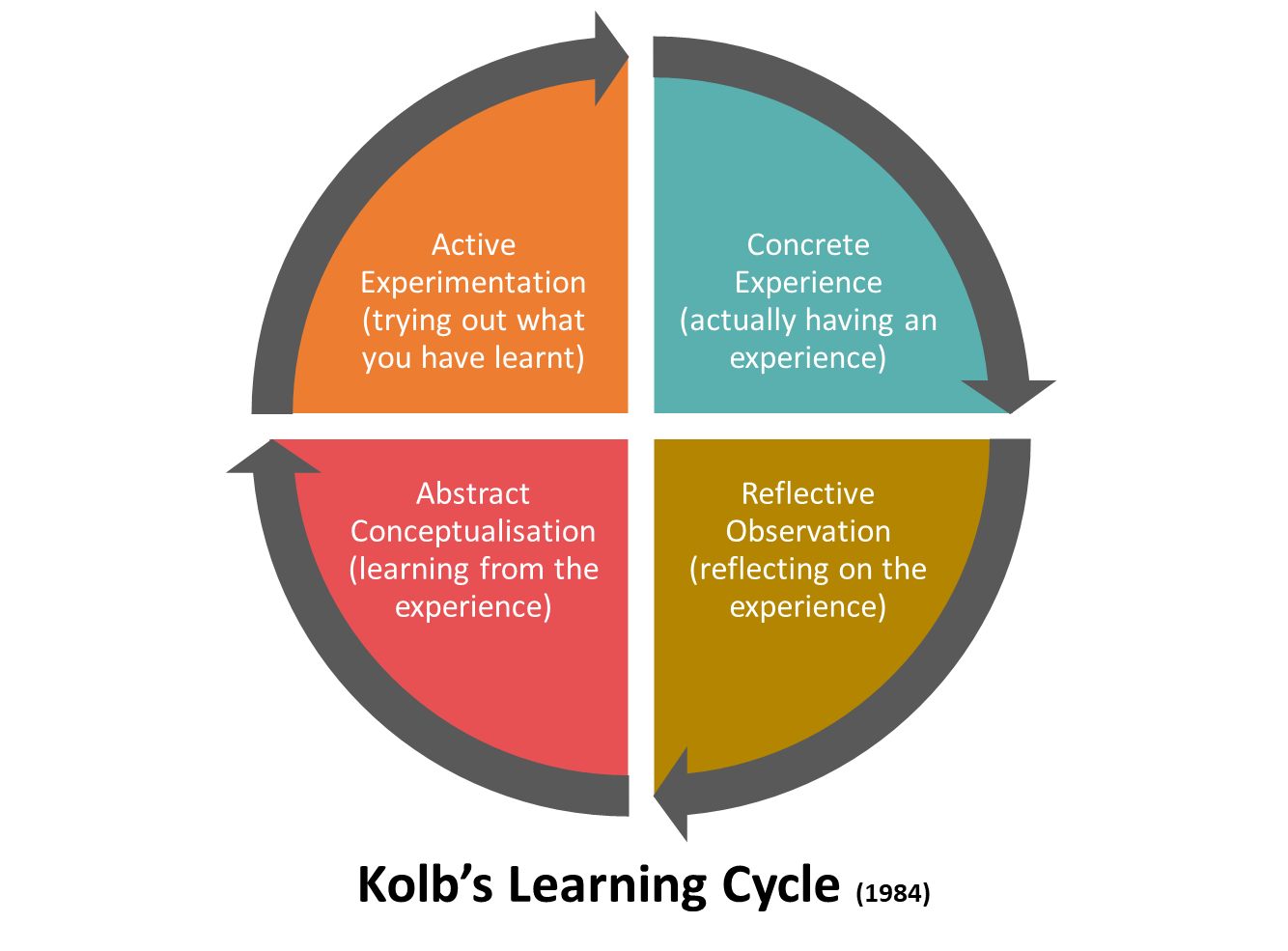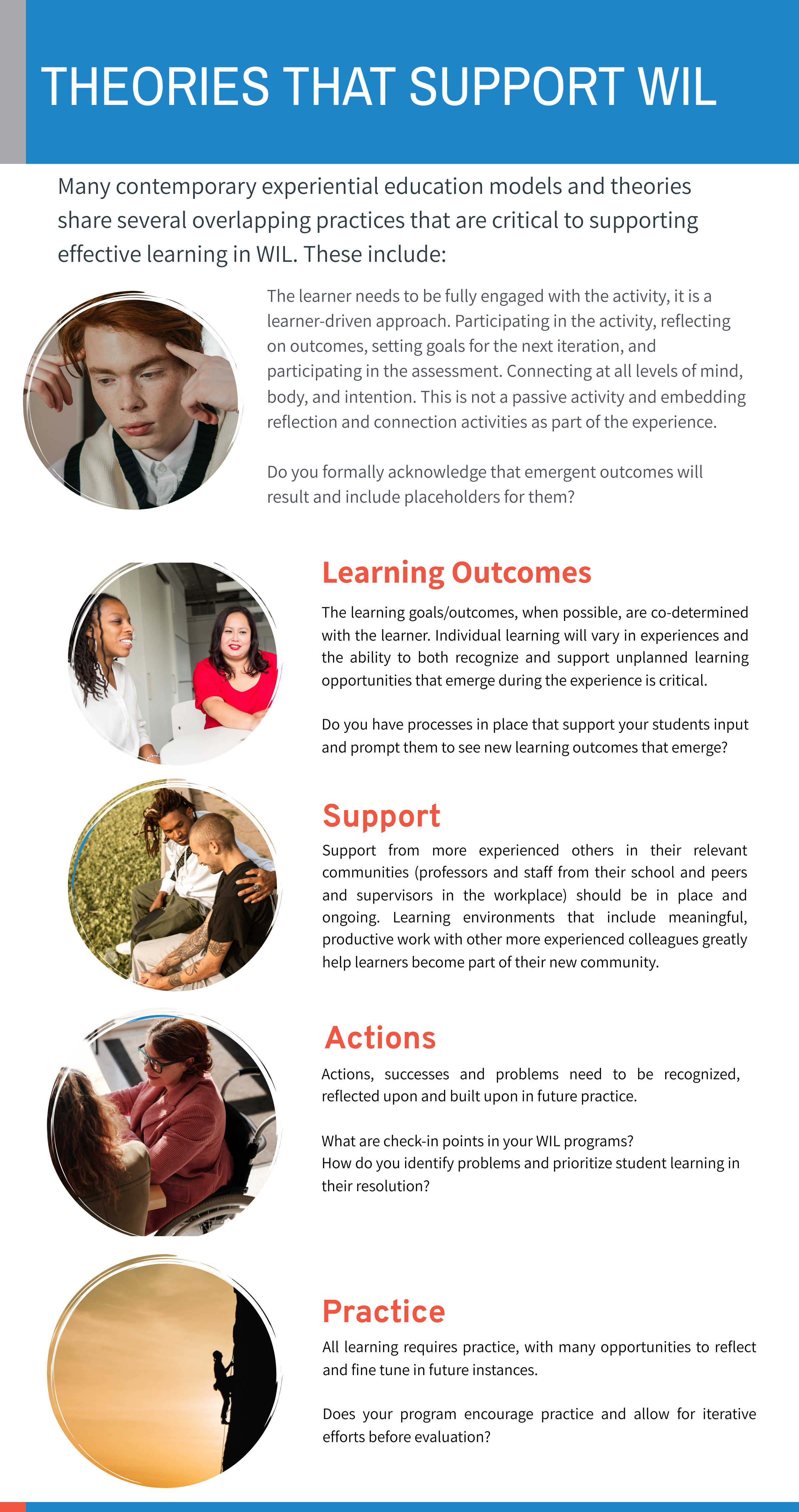Theories of Learning Through Experience
This section provides a basic overview of some theories that help explain how people learn from experience and contributes to the important Justice, Equity, Diversity and Inclusion (JEDI) concepts we considered in a prior section. There are certainly many other models and theories that could also assist our understanding of experiential education but we have selected a few that best inform some of the main attributes of WIL. While these theories help us generally understand how people learn through experience, it is also true that each learner brings their own unique histories and contexts to each experience, based upon how they see the world and how the world sees them. This diversity needs to be recognized and considered for each individual, and this starts with each of us better understanding the lenses through which we see the world and it us.
With a deeper understanding of how learning occurs in the WIL program(s) you manage, you can more confidently customize your own practice in ways that support student learning. The shared "messages" derived from various models and theories allow us to constitute a set of attributes of good practice related to student learning outcomes. These are the elements of your program you want to ensure remain supported. The more you as a practitioner understand the various requirements of your program (e.g., why students are asked to engage in certain activities such as reflective journaling, conducting self and professional assessments, writing work reports, curating online portfolios, etc.) the better you will be able to explain to students how these practices will advantage them. Understanding these distinctive features of experiential education will also help you better articulate how and why WIL is such an effective complementary learning approach.
Theories that Inform WIL
Several contemporary theorists and models can help us understand how students learn through their WIL experiences. Understanding work-integrated education as a learning model, even at a basic level, is necessary in order to improve how the expected learning is best supported. It is extremely difficult to modify an activity that you have always included in your work, such as a site visit for example, without a clear understanding of what parts of a student’s learning cycle that activity is intended to be supporting, and in what ways.
Some theories that inform learning in WIL focus on the importance of a learning "community of practice" and the value of social partnerships (e.g. Lave and Wenger, Bandura, Billett), others help us understand how learners learn iteratively as they reflect-in-and-on their own practice and mistakes and practice based on those reflections (e.g. Argyris and Schön, Mezirow). Others theories such as Kolb (see the graphic below) help us appreciate and support that experiential learning is cyclic, starting with observing something in the experience, reflecting upon it to understand it at a conceptual level then applying that concept in a new context and observing the outcome (and re-starting the cycle).

The reason we benefit from better understanding the theoretical models that underpin WIL, as well as the quality indicators that are supported by CEWIL (and other organizations) is so that we as WIL Practitioners can better understand our work and the learning we are supporting. Here are a few videos that help exemplify some of the theories of learning in WIL. Please choose to watch the ones that are of most interest to you now.
Pulling the Theories Together
The above videos provide high level overviews of key concepts underlying experiential education and inform learning experiences that:
- are situated or immersive in nature (such as a work placement);
- have opportunities for iteration (provide repeated opportunities for experiences and reflection);
- involve professional or workplace settings and/or problems; and
- have the potential for transformational outcomes.
As you can see there is no "one" theory of work-integrated learning but rather several models and concepts that help explain the complex systems at work when we learn by doing. Several of the above concepts share critical elements: the notion of full engagement of the learner, the importance of ensuring many opportunities for critical reflection, the importance of the context being relevant to where the learning is intended to be used, and the idea that disruptions and problems are essential to learning that can be transformational for the learner.
See the infographic below that outlines the attributes, which have implications for how we can design and deliver WIL in ways that enhance student learning.

Practices that support learning in WIL transcript.docx
 |
If you wish to engage in a deeper dive into the theoretical foundations literature, please see these articles: Calway, B., Murphy., G. The educational imperatives for a work-integrated learning philosophy. |
Reflective Prompts
 |
For each attribute, consider your WIL program by engaging with the following reflection questions: Thinking about the attributes, learning theories and concepts, how might you translate them to your own WIL program via various activities? Are students actively included in the program design and delivery at various stages of their journey? ( e.g. do they set their own learning goals? Do they get to determine their WIL activity? Do students self-assess and evaluate? Do they mentor other WIL students? Are the learning contexts of the WIL activity authentic? Are they closely related to the context the dominant skills and knowledge gained is intended to be used? (e.g. the student is an employee, the student is in a simulator environment, the student activity is on site and hands on, the project is provided by an employer host, the WIL activity is assessed by an employer host) How often, and in what ways, is critical reflection embedded in your design and delivery? (e.g. do students keep a reflective journal or blog? Do students work together upon return to campus to share and reflect on collective experiences? Do assignments and reports reflect more critical than descriptive reflection? |